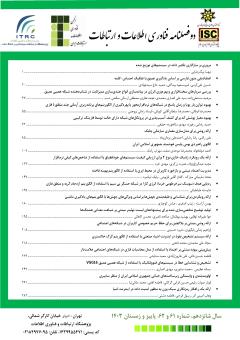ارائه یک رویکرد ژنتیک-فازی نوع 2 برای ارزیابی کیفیت سیستمهای خود انطباق با استفاده از شاخصهای کیفی نرم افزار
محورهای موضوعی : AI and Robotics
مجید عبدالرزاق نژاد
1
*
![]() ,
عشرت زرگری
2
,
مهدی خرد
3
,
عشرت زرگری
2
,
مهدی خرد
3
1 - عضو هیات علمی
2 - کارشناسی ارشد، گروه مهندسی کامپیوتر، دانشگاه آزاد اسلامی – واحد بیرجتد - ایران
3 - دانشجوی دکتری، گروه مهندسی کامپیوتر، دانشکده فنی و مهندسی - دانشگاه قم - قم - ایران
کلید واژه: سیستم خود انطباق, شاخصهای کیفی نرم افزار, الگوریتم ژنتیک, فازی نوع دو, سیستم خودانطباق کنترل ترافیک.,
چکیده مقاله :
امروزه با گسترش علم در حوزه مهندسی کامپیوتر، امکان توسعه سیستمهای هوشمند و سازگار با محیط نیز افزایش یافته است. سیستمهای خود انطباق یکی از انواع سیستمهای نرمافزاری هستند که رفتار خود را با توجه به شرایط محیطی تغییر میدهند و خود را با آن سازگار میکنند. اگرچه ارزیابی عملکرد این سیستمها در بیشتر تحقیقات تحت پوشش قرار گرفته شده است، ولی ارزیابی کیفیت آنها مغفول مانده است. اولین چالش در این مسیر، عدم قطعیت شاخصهای کیفی این سیستمها است که پارامترهایی ثابت، مشخص و قطعی ندارند. به عنوان مثال یکی از شاخصهای کیفی سیستم خودانطباق، توانایی اجرای نرمافزار در سیستمعاملهای مختلف است. این شاخص، از نظر افراد خبره مختلف، میتواند درجه اهمیت مختلفی داشته باشد. چالش دیگر، برخی شاخصهای کیفی متغیر ریاضی نیستند و یک متغیر زبانی بین کاربران و کارشناسان میباشند، که این امر نشان میدهد این کمیتهای کیفی، متغیرهای فازی بوده و با منطق فازی کاملا ً قابل فرموله شدن میباشند. در این مقاله به منظور ارزیابی کیفیت این سیستمها براساس شاخصهای کیفی نرم افزار اقدام به ارائه یک رویکرد ژنتیک-فازی نوع دوم شده است. جهت توصیف شاخصهای کیفی از منطق فازی نوع دوم و برای تعیین بهینه وزنهای فازی شاخصهای کیفی از الگوریتم ژنتیک استفاده شده است. در روش پیشنهادی سعی شده تا سیستمهای خودانطباق از دو بعد شامل بعد نرمافزاری این سیستمها و بعد خود انطباق آنها مورد مقایسه قرار گیرند. این در حالی است که اکثر تحقیقات موجود تنها به یک بعد میپردازند. جهت ارزیابی روش پیشنهادی از یک سیستم کنترل ترافیک با نام InSync که یک سیستم خودانطباق کنترل ترافیک (ATCS) بوده و حاوی شاخصهای متعدد کیفی میباشد استفاده شده است. نتایج بدست آمده باتوجه به عدم نیاز به تولید سناریو، توانایی بسط روش به تمامی شاخصهای کیفی نرم افزار و سادگی آن تایید کننده کارآمدی روش پیشنهادی میباشند. همچنین جامعیت بیشتر روش پیشنهادی را نسبت به سایر مدلهای ارزیابی موجود نشان میدهد.
The possibility of developing intelligent systems compatible with the environment has increased by expanding computer engineering fields. Self-adaptive systems are one of the types of software systems that change their behavior according to system conditions and environmental conditions and adapt themselves to it. Although the evaluation of the performance of these systems has been covered in most researches, the evaluation of their quality has remained closed. Therefore, designing an approach is an essential issue to evaluate the quality of self-adaptive systems. The first challenge, the quality indicators of these systems are not fixed, specific, and definite parameters. For example, one of the qualitative indicators for a self-adaptive system is the ability to run software on different operating systems. This indicator may have different degrees of importance for different experienced individuals. The next challenge, some qualitative indicators are not mathematical variables, but rather a linguistic variable between users and experts, indicating that these qualitative quantities are fuzzy variables and can be completely formulated by fuzzy logic. In this article, a new genetic-fuzzy type 2 approach has been proposed to evaluate the quality of the systems based on their quality indicators. The fuzzy logic type 2 is used to describe qualitative indicators, and a genetic algorithm is utilized to determine the optimal fuzzy weights of the qualitative indicators. In the proposed method, it has been tried to compare the self-adaptive systems from two dimensions, including the software dimension and their self-adaptive dimension. This is despite the fact that most of the existing research deals with only one dimension. In order to evaluate the proposed method, a traffic control system called InSync, which is an adaptive traffic control system (ATCS) and contains multiple qualitative factors, has been used. The obtained results confirm the effectiveness of the proposed method due to the lack of scenario generation, the ability to extend the method to all software quality parameters, and its simplicity. Also, the method is more comprehensive than other existing evaluation models. In addition, it has been tried to compare the self-adaptive systems from two dimensions, including the software dimension and their self-adaptive dimension. This is despite the fact that most of the existing research deals with only one dimension.

